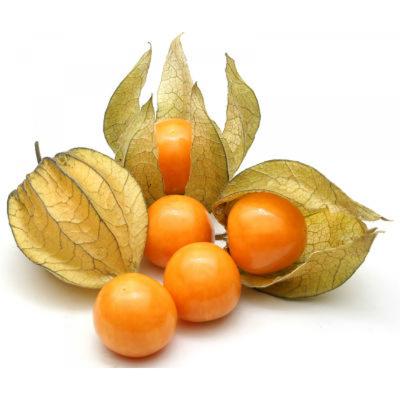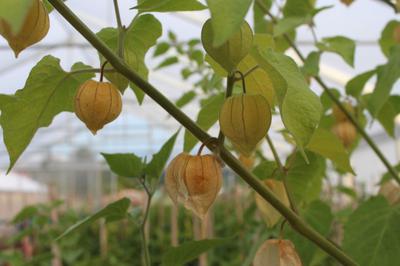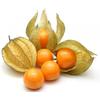VANILLA BEANS | SOYBEAN OIL | SOYMEAL & CAKE | COCOA BEANS | COFFEE BEANS
How to grow CAPE GOOSEBERRIES in Uganda

Cape Gooseberries in Uganda
Cape gooseberry/ goldenberry (Scientific Name: Physalis peruviana) is a marble-sized fruit that is yellow to orange in color with a smooth, waxy skin.
After the flower falls, the calyx expands, ultimately forming a beige husk fully enclosing the fruit.
The fruit is a round smooth berry, resembling a miniature yellow tomato 1.25–2 centimeters (0.49–0.79 in) wide.
Removed from its calyx, it is bright yellow to orange in color, and sweet when ripe, with a characteristic, mildly tart tomato flavor.
With origins in Peru and Chile the plant has been cultivated in England since the late 18th century and in South Africa in the region of the Cape of Good Hope since at least the start of the 19th century.
Widely introduced in the 20th century, Cape gooseberry is cultivated or grows wild across the world in temperate and tropical regions.
“Entutunu” as locally known in Uganda is vastly seen as a wild and self propagating plant found on farm lands.
Common Cape Gooseberry varieties in Uganda
There are no indigenous varieties of Cape goose berries classified in Uganda.
Soil requirements for growing gooseberries in Africa
Cape gooseberry thrives best on arable land. This should be well drained; clay loam soil with a pH 6 to 7.5.
If your site is poorly drained, you can improve your field by making raised beds.
How to Propagate Cape goose berries on your farm
Cape gooseberry can be propagated using seeds or using cuttings and these are able to give fruits in about 1-2 years.
Contact us here to buy Cape gooseberries and Cape gooseberry Seedlings in Uganda
How to plant gooseberries in Africa
Cape Goose berries are not common small fruits, so it’s hard to find the seeds of the plant not even in the agriculture import shops in the country.
Therefore the only option I would recommend is using cuttings of already established gooseberry plant or even layering the branch extensions.
The other easiest way would be to obtain a disease free seedling on order from a nursery bed operator.
To plant, dig up a planting hole in a space cleared for planting.
Add some compost or rotted manure to the soil put back to the bottom, you can add general purpose fertilizer if you have it.
Gently remove the seedling from the polybag and then set the root ball into the plating hole.
Firm the soil down around the roots. Maintain a spacing of 30cm-45cm between plants and 1.2m between rows, this allows access for picking.
Gooseberry bushes need the soil to be kept moist so keep plants well watered until established, and especially when the fruits are being formed.
In dry periods water them to keep the soil moist.
Have a spray against fruit fly, powdery mildew and aphids.
Contact us here to buy Cape gooseberries and Cape gooseberry Seedlings in Uganda
How best to Harvest Cape Gooseberries
The average life of gooseberry plants is between 15 to 20 years, and the plant starts bearing fruits in its first year as it stabilizes in the third year with higher yields.
Picking of the fruit starts when the fruit is calyx dries up and fruit inside turns orange from green.
To harvest, strip the gooseberries from their stalks using hands, leave the fruit within its calyx if you're not going to consume it immediately.
Then preserve the fruits in a fridge for a prolonged shelf life.
Contact us here to buy Cape gooseberries and Cape gooseberry Seedlings in Uganda
About the Market and uses of Cape Gooseberries
P. peruviana is an economically useful crop as an exotic exported fruit, and is favored in breeding and cultivation programs of many countries.
P. peruviana fruits are marketed in the United States as Goldenberry and sometimes Pichuberry, named after Machu Picchu in order to associate the fruit with its origin in Peru.
Cape gooseberry is made into fruit-based sauces, pies, puddings, chutneys, jams, and ice cream, or eaten fresh in salads and fruit salads.
Because of the fruit's decorative appearance in its showy husk, it is popular in restaurants as an exotic garnish for desserts.
To enhance its food uses, hot air drying improved qualities of dietary fiber content, texture, and appearance.
In basic research on fruit maturation, the content of polyphenols and vitamin C varied by cultivar, harvest time, and ripening stage.
The fruit has a limited history for treating disorders in traditional medicine.
In Uganda Cape gooseberries are random fruits on the market, those who collect them either supply them to fruit hawkers, stalls in the farmer market like Nakaseero, and even road side fruit sellers.
Contact us here to buy Cape gooseberries and Cape gooseberry Seedlings in Uganda
Quick tips for planting cape gooseberries in Uganda
- Open up space meant for planting by clearing all barriers.
- Dig pits twice the size of the seedling root ball with a spacing of 30cm_45cm between crops and 1.2m in rows.
- Mix the top soils you removed with compost and then put it back to the pit half of it.
- Remove the polybag sleeve from the seedling root ball, and then carefully loosen the root area.
- Plant the seedling plants in the center of the pits and stake it.
- Water the seedling before and immediately after plating.
- Have a weeding, spraying, and fertilizing routine.
Contact us here to buy Cape gooseberries and Cape gooseberry Seedlings in Uganda
Join in and write your own page! It's easy to do. How? Simply click here to return to Plants Guide.
If you haven't yet found what you were looking for or you need detailed information about the subject matter on this page then... feel free to ask our business travel consultants. |







